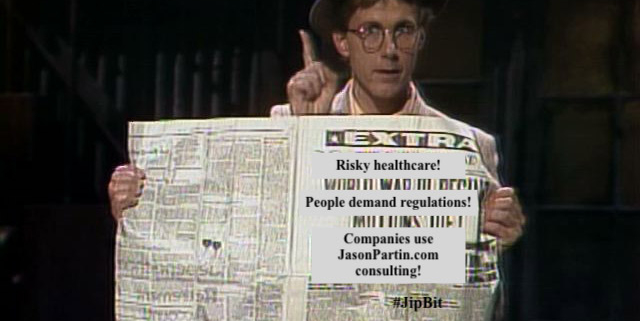How to apply risk-controls and risk-benefit analysis
4 minute read.
This article shows how to apply risk-control and perform Risk-Benefit analysis for the European Union Medical Device Regulation. You may have reached this from my article on the MDR big picture; Risk-Benefit analysis the final step in reducing risk As Far As Possible. I’ll use Harry “The Hat” Anderson to illustrate that concept.
Harry Anderson was a famous comedian, magician, actor, and producer. He was most known for his role as Judge Harry Stone in television’s Night Court, where he played a judge in New York City who did magic tricks. His career had jump-started in 1983 when he appeared on the famous comedy show Saturday Night Live, apparently shoving a needle through his arm.
I remember him fumbling for written instructions with a needle stuck through is bleeding arm, and this “stuck” in my mind as a way to illustrate the concept of risk control. Companies are required to apply risk control in specific ways, and many companies struggle to balance cost effectiveness, innovation, and applying risk control priorities; this article may help clarify the “point.”
Risk Control Priorities
Harry fumbling for written instructions is why the EU-MDR prioritizes risk control methods:
Make the design inherently safeAdd safeguardsProvide written instructions or warnings

His needle-through-the-arm also represents a real-world challenge in healthcare, accidental needle sticks. Healthcare workers would get stuck by needles that had been in contact with patient blood, which resulted in transmission of diseases. Some of those diseases included life-threatening viruses such as HIV.
Written instructions were ineffective at protecting healthcare workers, and it was difficult to make needles inherently safe because it must be sharp to penetrate patient skin. Innovative companies found cost-effective ways to add safeguards to needle after FDA regulations for needles required more safety, and those companies excelled in the market. Companies that didn’t innovate lost in the market. Society benefited.


Safeguards have proven to be more effective than written warnings, and maybe one day an innovative company will revolutionize needles with an inherently safe design. When that happens they will be the new state of the art; innovative companies that focus on patient safety will continue to win, and society will continue to benefit.
Risk/Benefit Analysis

After risk control the needles still have sharp tips, which is why the final step of reducing risk as far as possible is documenting a risk/benefit analysis. In other words, you must show that benefits to the patients outweigh remaining risks.
The EU MDR requires companies to create two documents for determining risk-benefit, clinical data and post-market surveillance. For this article it’s enough to understand that clinical data is simply a list of everything that could be known at the time, including publicly-available information about the problem and competitors’ solutions.
Public information:

Competitors’ solutions:

Post market surveillance is real-world evidence of your device’s risk, adverse events, and trends that would indicate potential risks to future patients.
Risk/Benefit analysis means comparing post-market surveillance against clinical data to ensure a company’s product is as safe as competitive options. Any remaining risks or any additional risks must be balanced by additional benefits to patient healthcare; this is the Risk/Benefit document required by the MDR.
In a few cases added risk would justified, such as risky cancer treatments for patients without safer alternatives. That’s not true for most medical devices though. If someone you loved needed a medical device, how would you justify using your product if it were more likely to cause them harm than a competitor’s product? Why shouldn’t every company do that for all of our loved ones? The EU-MDR forces companies to do this so that we don’t have to.

Clinical data and post-market surveillance must be updated every 1-2 years for devices classified as high-risk, and “as needed” for low-risk devices. (See my article on classifying devices). A company must continuously improve their products to remain state-of-the-art, showing that their benefits outweigh risks compared to competitive products. That’s fair.
Continuous learning
Learn more by using the 2014 consensus paper for EN ISO 14971:2012and theEuropean Union Medical Device Regulation. Or hire consultants to work with your teams or train them.
Oriel STAT-A-MATRIX (I consult with Oriel)
Thank you
Please share this article if you think others could benefit.
Follow me on Linkedin, browse my blog, or subscribe for semi-annual updates.
Parting Thoughts
Harry Anderson passed away in 2018. My thoughts were with him and his family when I wrote an article trying to summarize all of the wonderful things that happened in my life due to the humor and magic he shared with us. If you’re not familiar with Harry’s style of humor, here’s one of my favorite scenes of him on television’s Cheers:
Coincidentally, my first medical device job was with a start-up company that had been founded by the original inventor of needle-stick safety features. In our interview he asked me how I would solve the problem. By then I had designed or invented dozen of magic effects, many of them from Harry Anderson’s appearances on Saturday Night Live. That job led to a series of my own medical device inventions, retirement, and transitioning into teaching using hands-on, project-based learning where many of my students design and perform magic tricks to develop engineering and public speaking skills.
If you’re interested, I wrote a rough draft of this article that explains how Harry helped me teach risk, design, and entrepreneurship, where I describe sharing drinks with Harry in his New Orleans bar, where we performed a few magic tricks together. I didn’t think to thank him then. I wonder whom I should thank today.
Life’s too short for many people; I wish you happiness.

